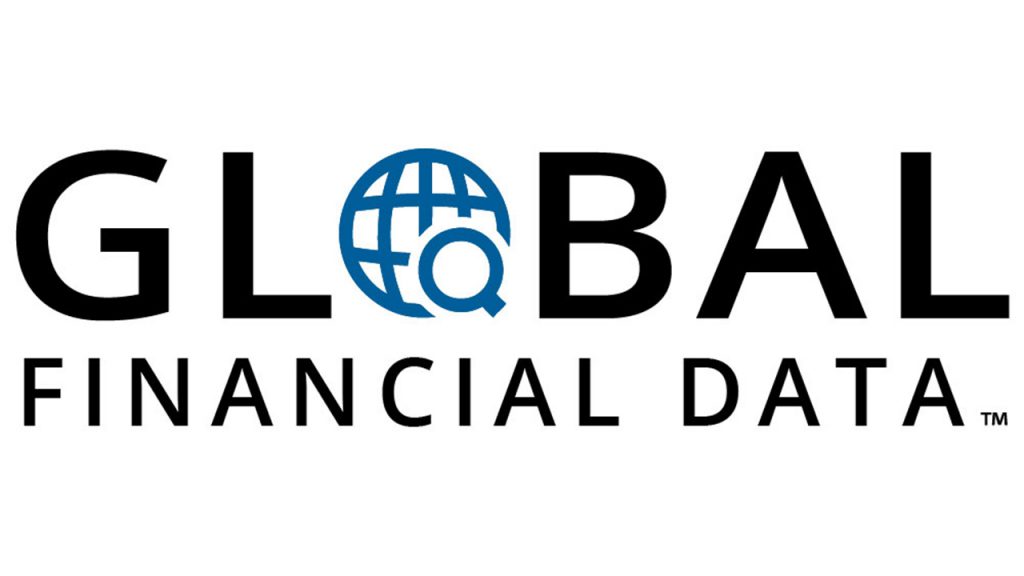 Global Financial Data has added almost 300 new stock and commodity indices for users of the Global Financial Database. The new indices expand GFD’s coverage of equities into new areas.
GFD has added a number of indices that are calculated by Research Affiliates. These indices use a weighting that differs from traditional indices. Most equity indices are either equally weighted (as with the Dow Jones Industrial Average) in which the index assumes one share of each component is owned, or is capitalization-weighted, in which the larger the capitalization of the company, the larger the weight in the index (as with the S&P 500).
For the Research Affiliate Indices, index constituents are weighted using a composite of fundamental factors, including total cash dividends, free cash flow, total sales and book equity value. Prices and market values are not determinants of the index weights. Consequently, the indices are less prone to excessive concentration arising from market fads, which can result in over-exposure to individual companies, sectors or countries.
GFD is also offering a number of shariah-based indices. Companies involved in any of the following activities will be filtered out as non-Shariah compliant: Conventional finance (non-Islamic banking, finance and insurance, etc); Alcohol; Pork related products and non-halal food production, packaging and processing or any other activity related to pork and non-halal food; Entertainment (casinos, gambling and pornography); Tobacco, weapons, arms and defense manufacturing.
GFD has also added new indices for Europe, both the FTSEurofirst Supersector Indices and the Russell Europe Small-Midcap Indices as well as Supersector indices based upon the FTSE-350 indices from the United Kingdom. GFD has added the Sindex which includes only sinful stocks as well as the FTSE4good Environmental Leaders Europe 40. To obtain a full list of the series that have been added to the GFDatabase, call today to speak to one of our experts at 877-DATA-999 or 949-542-4200.
Global Financial Data has added almost 300 new stock and commodity indices for users of the Global Financial Database. The new indices expand GFD’s coverage of equities into new areas.
GFD has added a number of indices that are calculated by Research Affiliates. These indices use a weighting that differs from traditional indices. Most equity indices are either equally weighted (as with the Dow Jones Industrial Average) in which the index assumes one share of each component is owned, or is capitalization-weighted, in which the larger the capitalization of the company, the larger the weight in the index (as with the S&P 500).
For the Research Affiliate Indices, index constituents are weighted using a composite of fundamental factors, including total cash dividends, free cash flow, total sales and book equity value. Prices and market values are not determinants of the index weights. Consequently, the indices are less prone to excessive concentration arising from market fads, which can result in over-exposure to individual companies, sectors or countries.
GFD is also offering a number of shariah-based indices. Companies involved in any of the following activities will be filtered out as non-Shariah compliant: Conventional finance (non-Islamic banking, finance and insurance, etc); Alcohol; Pork related products and non-halal food production, packaging and processing or any other activity related to pork and non-halal food; Entertainment (casinos, gambling and pornography); Tobacco, weapons, arms and defense manufacturing.
GFD has also added new indices for Europe, both the FTSEurofirst Supersector Indices and the Russell Europe Small-Midcap Indices as well as Supersector indices based upon the FTSE-350 indices from the United Kingdom. GFD has added the Sindex which includes only sinful stocks as well as the FTSE4good Environmental Leaders Europe 40. To obtain a full list of the series that have been added to the GFDatabase, call today to speak to one of our experts at 877-DATA-999 or 949-542-4200.
 The United States stock market has been in bull-market mode for six years now, and some fear the stock market may be running out of steam. By our count, there have been 25 bear markets in the United States since 1792 and 28 bear markets in the United Kingdom since 1692. Are we about to add to that list?
This raises the question, when did that ugly bear first raise its head? By our analysis, the first fateful year was 1692 when a four-year bear market began in England. If we take the price of East India Company stock from March 1692 until July 1694, and the price of Bank of England stock from August 1694 until October 1696, the market fell almost 72% for the four years between March 1692 and 1696. The first bear market was also one of the worst.
The United States stock market has been in bull-market mode for six years now, and some fear the stock market may be running out of steam. By our count, there have been 25 bear markets in the United States since 1792 and 28 bear markets in the United Kingdom since 1692. Are we about to add to that list?
This raises the question, when did that ugly bear first raise its head? By our analysis, the first fateful year was 1692 when a four-year bear market began in England. If we take the price of East India Company stock from March 1692 until July 1694, and the price of Bank of England stock from August 1694 until October 1696, the market fell almost 72% for the four years between March 1692 and 1696. The first bear market was also one of the worst.
The Nine Years War and the Four Year Bear Market
What was the cause of the world’s first bear market? Although CNBC wasn’t around in 1692 to tell us the causes, the most likely source was the setbacks the British army and the Dutch suffered at the hands of French troops in the Nine Year’s War (1688-1697), as well as the ongoing controversy over who was the true King of England. The groundwork for the Nine Year’s War had been laid a decade before. Louis XIV, the “Sun King”, emerged from the Franco-Dutch War in 1678 as the most powerful king in Europe, but Louis XIV of “L’etat c’est moi” fame, was not content and wanted to extend his gains. Louis XIV’s revocation of the Edict of Nantes in 1685 contributed to the deterioration in his military and political dominance outside of France, and when Louis XIV’s troops crossed the Rhine in September 1688, his opponents put together an alliance to stand up to the French King. Queen Mary of England, the Anglo-Dutch Stadtholder King William III, the Holy Roman Emperor Leopold I, King Charles II of Spain, Victor Amadeus II of Savoy and major and minor princes of the Holy Roman Empire formed an alliance to stop Louis XIV. Most of the fighting occurred near France’s borders, mainly in the Spanish Netherlands and the Rhineland. Although there was a fear of a French invasion of England at the beginning of the war, this never occurred, in part because of victory at the Battles of Barfleur and La Hogue between May 29 and June 4, 1692. Nevertheless, Anglo-Dutch forces were defeated at the Battle of Steenkerqe on August 3, 1692, and the Dutch and English suffered defeats at the Battle of Lagos off Portugal on June 27, 1693 (N.S.) and the Battle of Landen near Neerwinden on July 19, 1693 (N.S.). These defeats began to be reflected in the stock market. The expense of the war gradually led to financial exhaustion of the participating countries. To help the King William III fight these wars, the Bank of England was established on July 27, 1694 to provide funds to the crown. In exchange for the establishment of the Bank of England, the king received a loan that would never have to be paid back. After Queen Mary died on December 28, 1694, King William III became the sole ruler of England. When Savoy defected from the Alliance, the Allies and France were eager to negotiate a settlement. The war finally came to an end with the Treaty of Ryswick, signed on September 20, 1697 in which Louis XIV retained Alsace, gave up Lorraine and recognized William III as the sole ruler of England, Scotland and Ireland.From Bear to Bubble
During the war, the price of East India Company stock fell from 158 on March 30, 1692 to 38 on November 6, 1696 while Bank of England stock fell from a par of 100 in August 1694 to 60 on October 16, 1696. From there, both stocks began to rise in value as the Nine Year’s War began to wind down. Global Financial Data has stock histories for over 50,000 securities. Some of these stocks cover centuries of data; others are quite short, lasting only a few months or even a few days. One of the most interesting of these is Wilt Chamberlain’s Restaurants, Inc. for which there are only two days of data.
Global Financial Data has stock histories for over 50,000 securities. Some of these stocks cover centuries of data; others are quite short, lasting only a few months or even a few days. One of the most interesting of these is Wilt Chamberlain’s Restaurants, Inc. for which there are only two days of data.
Wilt the Stilt
Wilt Chamberlain was one of the greatest, some would argue the greatest, basketball players in history. He holds 71 NBA records, and he is the only person to score 100 points in a single game. He averaged more than 40 to 50 points per game in some seasons, and in one season he played every minute of every game. Chamberlain was 7-foot 1-inch and played for the University of Kansas, Harlem Globetrotters, the Philadelphia/San Francisco Warriors, Philadelphia 76ers and the Los Angeles Lakers. He dominated the NBA between 1959 and 1973 and left a legacy that few can match. After Chamberlain left the NBA, he promoted the short-lived International Volleyball Association, wrote a book, appeared in the movie Conan the Destroyer, and tried several business ventures. One of these was Wilt Chamberlain’s Restaurants, Inc. Wilt Chamberlain’s restaurant opened on December 20th, 1990 in Boca Raton, Florida. The restaurant was a sports-themed, casual-dining family restaurant. The goal of the restaurant was fine food and service for families, a sports bar for drinkers and an entertainment complex for kids of all ages. The restaurant had over fifty televisions broadcasting sports events for its patrons as well as a basketball court and hoops where customers could shoot a few shots while enjoying their drinks or waiting for a table. The restaurant had a live arcade with over 40 games, and a redemption center where customers could either cash in their tickets or purchase sports-related goods.The IPO that went PU
The restaurant was successful, so in 1992, Wilt Chamberlain decided to go public. The Hard Rock Café had begun its expansion in 1982 and in 1991 Planet Hollywood was founded by Sylvester Stallone, Bruce Willis, Demi Moore and Arnold Schwarzenegger. There was no reason why a sports-themed restaurant shouldn’t succeed as well, but to do so Wilt Chamberlain would need more capital. Chamberlin contracted with New York-based brokerage Meyers, Pollock, Robbins Inc. to go public. The goal was to raise $8 million through the initial public offering (IPO) in order to fund the restaurant’s expansion. The company filed an SB-2 registration in which the brokerage firm said they would offer 1.4 million shares, priced at $6 to $8. The company was had reported a profit of $222,706 for the nine months ended Sept. 30, 1992. Wilt Chamberlain signed an agreement to allow his name, likeness and persona to be used in connection with marketing the company. Although there was only one Wilt Chamberlain restaurant at the time, the company had plans to open additional restaurants across the United States and possibly worldwide. The company would trade under the symbol WILT. Unfortunately, the IPO was a disaster. Although Meyers, Pollock, Robbins, Inc. had been in business for 50 years, they had never underwritten an IPO. Their inexperience contributed to the fiasco, and they botched the placement completely. Most investment bankers will guarantee the IPO price for 30 days after the debut, but shares in Wilt Chamberlain Restaurants, Inc. stayed above the offering price for only a few minutes. Wilt Chamberlain Restaurants, Inc. went public at $7 a share on Thursday, February 11, 1993. The first trade in the stock was at $7.50, but the price fell to $6.75 a few minutes later. Over one million shares traded on its opening day, and the stock price closed at $6, $1 below the IPO price. This brought on short-sellers when it was apparent the firm could not or would not support the stock. By the next day, the stock closed at $4.625 a share. Everyone who owned stock in the company was losing money, many of whom were clients of Meyers, Pollock, Robbins, Inc.IPO Money on the Rebound
Meyers, Pollock, Robbins, Inc. had gauged the price of the stock inaccurately and were unable to support the stock when it fell below its offer price. Over the weekend, the company and the underwriter huddled to figure out a strategy for their failed IPO. Before trading began on Tuesday, Meyers, Pollock, Robbins, Inc. announced that they would cancel the public offering. The underwriter had the legal right to do this because an IPO can be cancelled if the shares have not been distributed and no trades have settled. Global Financial Data has added new graphing tools to its website to enhance our customers’ ability to study our extensive database. The new graphing tools make it easier to visualize our data. In addition, GFD has added new techniques to understand the underlying data. To access the new tools, click on the Finaeon Graphs tab at the top of the user interface.
The Finaeon graphs provide a new, easy-to-use format that enables you to make numerous changes to the graph at once. Simply choose the changes in the settings you want and click on the Graph button. You can make changes to the duration, the type of graph, the periodicity, the currency, the scaling, add moving averages, show splits and dividends and adjust for inflation all at once. You can change all or your settings again, hit reset and start from scratch, or enter a new symbol to graph the data in a new file or stock.
In addition to improved ease of use, new tools have been added to the Finaeon Graphs. The comparison tools have been improved to allow multiple comparison of different files on the same graph. You can make a direct comparison, indirect comparison, compare files using different scaling, or compare files on a percentage basis. You can also divide different indices, such as large-cap and small-cap indices, to see how they have performed relative to one another, or you can subtract the yield on a 10-year bond and a 3-month T-bill to create your own interest rate spread.
Global Financial Data has added over two dozen new technical indicators to help you analyze individual stocks, indices and other files in the GFDatabase. Included in the new technical indicators are Bollinger Bands, Chaikin Oscillator, Williams R, Commodity Channel Index and others.
The new Finaeon graphs are designed to improve ease of use and provide new tools to analyze the 200,000 files that GFD now offers its clients. Please feel free to test the new graphs on your own, or if you would like a demonstration of the new graphs, please call today to speak to one of our experts at <ahref="tel:18773282999">877-DATA-999 or 949-542-4200.</ahref="tel:18773282999">
Global Financial Data has added new graphing tools to its website to enhance our customers’ ability to study our extensive database. The new graphing tools make it easier to visualize our data. In addition, GFD has added new techniques to understand the underlying data. To access the new tools, click on the Finaeon Graphs tab at the top of the user interface.
The Finaeon graphs provide a new, easy-to-use format that enables you to make numerous changes to the graph at once. Simply choose the changes in the settings you want and click on the Graph button. You can make changes to the duration, the type of graph, the periodicity, the currency, the scaling, add moving averages, show splits and dividends and adjust for inflation all at once. You can change all or your settings again, hit reset and start from scratch, or enter a new symbol to graph the data in a new file or stock.
In addition to improved ease of use, new tools have been added to the Finaeon Graphs. The comparison tools have been improved to allow multiple comparison of different files on the same graph. You can make a direct comparison, indirect comparison, compare files using different scaling, or compare files on a percentage basis. You can also divide different indices, such as large-cap and small-cap indices, to see how they have performed relative to one another, or you can subtract the yield on a 10-year bond and a 3-month T-bill to create your own interest rate spread.
Global Financial Data has added over two dozen new technical indicators to help you analyze individual stocks, indices and other files in the GFDatabase. Included in the new technical indicators are Bollinger Bands, Chaikin Oscillator, Williams R, Commodity Channel Index and others.
The new Finaeon graphs are designed to improve ease of use and provide new tools to analyze the 200,000 files that GFD now offers its clients. Please feel free to test the new graphs on your own, or if you would like a demonstration of the new graphs, please call today to speak to one of our experts at <ahref="tel:18773282999">877-DATA-999 or 949-542-4200.</ahref="tel:18773282999">


